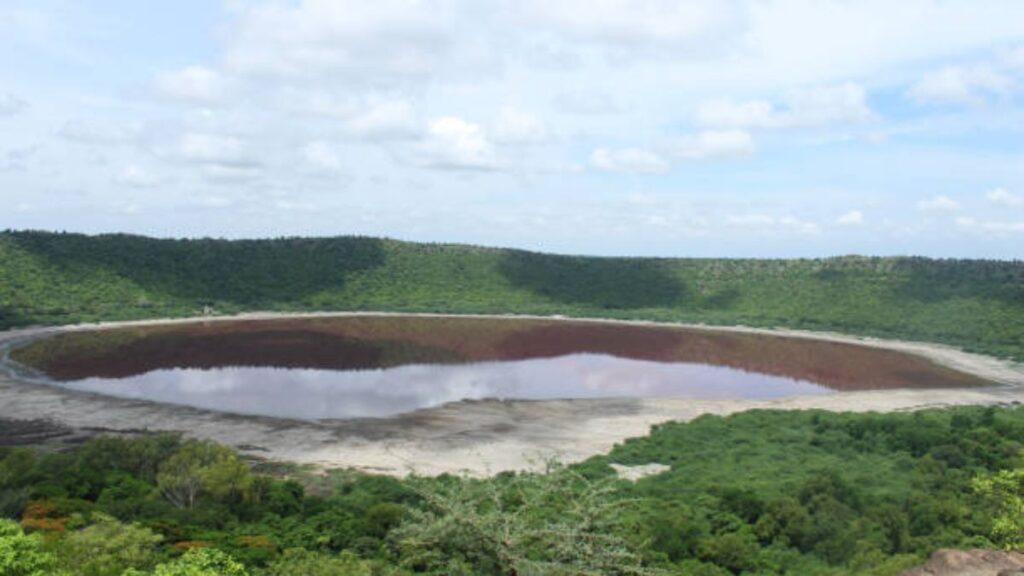Mysterious place in Maharashtra where compasses don’t not work and the sand is magnetic

There is a place in Maharashtra that is so mysterious that even its sand is magnetic and compasses behave unpredictably here. Even the wildlife here is different from its surrounding areas, as if this place is from another planet.
Formed approximately 52,000 years ago by a meteor impact, Lonar Lake in Maharashtra stands as one of nature’s hidden gems. This extraordinary crater was formed due to a meteorite, weighing 2 million tons, travelling at an estimated speed of 90,000 kmph, crashing into the earth this spot. Although thousands of meteors plummet towards Earth annually, none have resulted in a formation quite like Lonar Lake.

From above, Lonar Lake might appear as just another body of water. However, this near-perfect oval lake is one of the only two natural craters in the world formed entirely from basalt, a dark, fine-grained volcanic rock. Its waters are uniquely seven times saltier than seawater, adding to its mystique.
Its chance discovery
For centuries, Lonar Crater remained hidden as one of Maharashtra’s best-kept secrets. Located about 170 km from Aurangabad and 550 km from Mumbai, the lake was virtually unknown. The path to the lake was treacherous, with slippery terrain and banks believed to be quicksand swamps, deterring exploration.
It wasn’t until 1823, nearly 200 years ago, that British explorer JE Alexander noticed the crater while researching the region’s ancient temples. He discovered many dilapidated temples and a unique ecology within the crater, distinct from the surrounding flat landscape. Despite this, scientists initially believed the crater to be volcanic, given its location on the Deccan plateau, known for its volcanic origins.
Legends of Lonar Lake
There are stories that suggest more mythical origin for Lonar Lake, suggesting it was formed when the demon Lonasura, who tormented locals, was vanquished by Lord Vishnu and thrust into the ground with immense force. This legend highlights the lake’s cultural significance, alongside its scientific explanation.
Known as the ‘Bowl of Mysteries,’ Lonar Lake is surrounded by numerous unanswered questions and speculations. This meteorite enigma has drawn the attention of scientists, astronomers, geologists, ecologists, and even NASA.
A place where compasses don’t work

Another mystery is the malfunctioning of compasses near the lake. Visitors often find their compass directions either stop working or display significant deviations. This anomaly has been attributed to unusual electromagnetic waves interacting with electrical equipment, possibly due to the lake’s meteor-impact origin.
A lake with both saline and alkaline content
From a scientific perspective, it’s nearly impossible for a lake to be both alkaline and saline at the same time. However, Lonar Lake challenges this claim. The lake has two distinct sections that remain separate: an outer neutral region and an inner alkaline region, each hosting unique flora and fauna. This remarkable characteristic has prompted extensive research by NASA and the Geological Survey of India.
Traces of Moon mineral

NASA has noted similarities between the crater’s volcanic basalt and the craters on the moon’s surface. The presence of specific rock minerals, such as micro breccias and glass spherules, draws parallels to lunar geology. Additionally, a newly identified bacterial strain at the lake’s site resembles one found on Mars.
The lake turned pink overnight

In 2020, Lonar Lake underwent a dramatic transformation when its water turned pink, baffling observers. The phenomenon prompted government-ordered studies. Some scientists attribute the colour change to algae, increased salinity, or a microbe called Halobacteriaceae, known for its pink hue.









